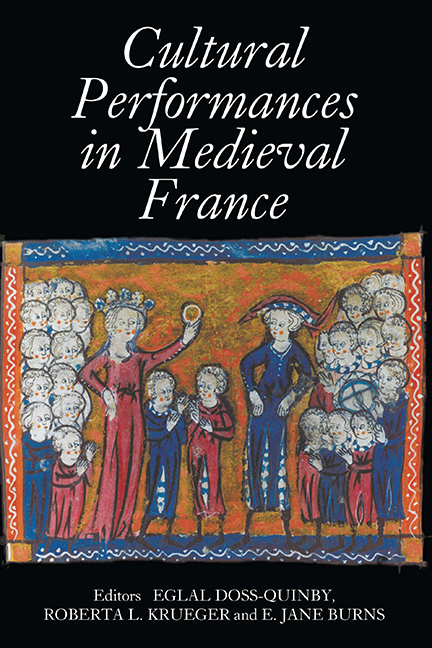Book contents
- Frontmatter
- Contents
- List of Illustrations
- Contributors
- Introduction
- Nancy Freeman Regalado, Curriculum Vitae
- PART I POETIC AND MUSICAL PERFORMANCES
- PART II PERFORMING SEXUAL AND SOCIAL IDENTITIES
- PART III DEVOTIONAL PRACTICE AND TEXTUAL PERFORMANCE
- Performing Vernacular Song in Monastic Culture: The lectio divina in Gautier de Coinci's Miracles de Nostre Dame
- Performative Reading: Experiencing through the Poet's Body in Guillaume de Digulleville's Pèlerinage de Jhesucrist
- The Anglo-Norman Office of the Cross in the Lichtenthal Psalter
- “Laver de ses pechiés une pecheresse royale”: Psalm Collects in an Early Fourteenth-Century Devotional Book
- PART IV PERSUASIVE PERFORMANCES
- PART V RE–ENACTMENTS AND LEGACIES
- Tabula Gratulatoria
- Tabula Gratulatoria
Performing Vernacular Song in Monastic Culture: The lectio divina in Gautier de Coinci's Miracles de Nostre Dame
from PART III - DEVOTIONAL PRACTICE AND TEXTUAL PERFORMANCE
Published online by Cambridge University Press: 24 October 2017
- Frontmatter
- Contents
- List of Illustrations
- Contributors
- Introduction
- Nancy Freeman Regalado, Curriculum Vitae
- PART I POETIC AND MUSICAL PERFORMANCES
- PART II PERFORMING SEXUAL AND SOCIAL IDENTITIES
- PART III DEVOTIONAL PRACTICE AND TEXTUAL PERFORMANCE
- Performing Vernacular Song in Monastic Culture: The lectio divina in Gautier de Coinci's Miracles de Nostre Dame
- Performative Reading: Experiencing through the Poet's Body in Guillaume de Digulleville's Pèlerinage de Jhesucrist
- The Anglo-Norman Office of the Cross in the Lichtenthal Psalter
- “Laver de ses pechiés une pecheresse royale”: Psalm Collects in an Early Fourteenth-Century Devotional Book
- PART IV PERSUASIVE PERFORMANCES
- PART V RE–ENACTMENTS AND LEGACIES
- Tabula Gratulatoria
- Tabula Gratulatoria
Summary
Gautier de Coinci cast his Miracles de Nostre Dame as a single long performance. Most of his work calls for narrative recitation of miracle stories composed in octosyllabic rhymed couplets, while his songs, many of which are set to the melodies of the trouvères’ “greatest-hits,” call for minstrel-like singing. These performance practices are easily recognizable from secular literary models, romances and love songs, and they are well suited to the recreational purpose of the Miracles de Nostre Dame. As I have argued elsewhere, Gautier explicitly designed his work as a spiritual literary recreation for monks, nuns, and pious laypersons to replace the secular fare that they habitually turned to for relaxation. This essay will show that toward the end of the Miracles de Nostre Dame, Gautier's performance practice shifts from recreation toward the disciplined devotional habits of monks. In his concluding cycle of sermons, prayers, and song, Gautier introduces a monastic practice, the lectio divina, that was usually applied to the meditative reading of Scripture. His final song, Entendez tuit ensamble II Ch 36), is the pivotal poem where this shift occurs, for it conveys monastic mnemonics and hermeneutics by means of secular poetic techniques. This calls for a slight but significant change in performance practice, for instead of being recreational, the final song is meditative. Consequently, the singer must subtly turn his mind away from his audience, inwards towards his own heart, and then, in meditative solitude, turn upward to God. Composed in the early thirteenth century, this song stands at the cusp of the great metamorphosis that spiritual reading practices would undergo in vernacular and Latin literatures throughout the high Middle Ages.
Lyric citation is the poetic mechanism that allows Gautier to transform his final song into a meditation. Gautier used all manner of lyric citation techniques, but nowhere did he do so more elaborately than in his final song. The song is set to the melody of the famous Notre Dame monophonic conductus, Beata viscera, whose words were composed by Philip the Chancellor, and melody by Perotinus. Moreover, Gautier set the melody of Beata viscera to two different songs in his collection, De sainte Leochade (I Ch 47) and Entendez tuit ensamble (II Ch 36).
- Type
- Chapter
- Information
- Cultural Performances in Medieval FranceEssays in Honor of Nancy Freeman Regalado, pp. 123 - 134Publisher: Boydell & BrewerPrint publication year: 2007

